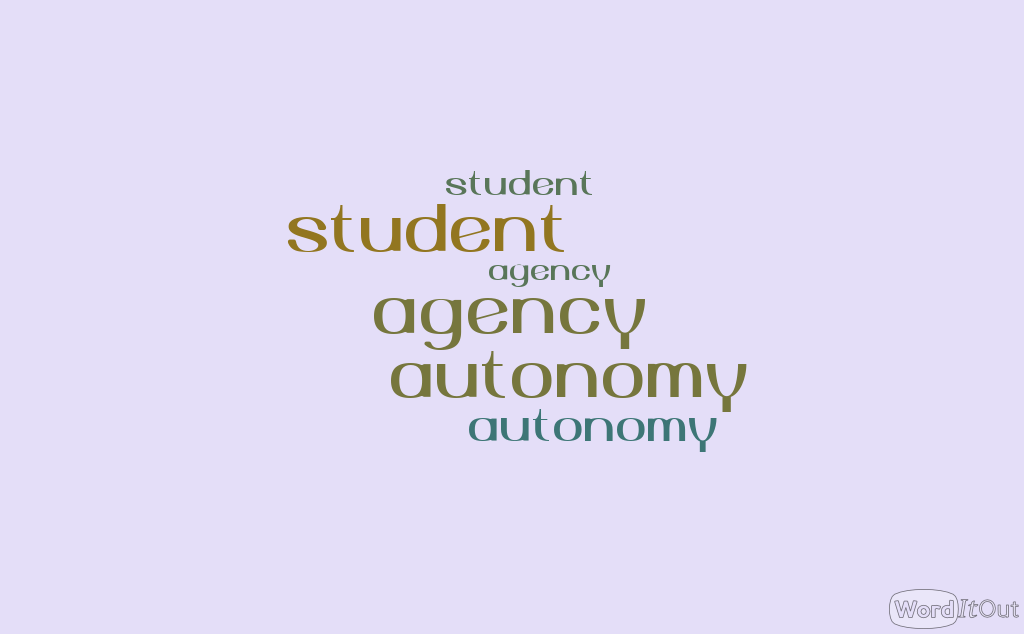September is here! The past eight months of warnings of artificial intelligence- or AI- generative chat calamities were heeded by some and ignored by others. Hopefully, you are one of the fortunate ones who work in an institution where AI policies, guidelines, just-in-time support and plagiarism teaching-learning plan statements are ready and accessible to supervisors, instructors and learners. If this is not your situation, this post is for you. Read on to quickly pick up some tips to cope with AI generative chat technologies while your institution works towards comprehensive strategies.
Category Archives: Educational research
Building Student Agency and Autonomy
Providing students with various platforms and activities where they can voice their learning helps create an engaging learning environment where students feel autonomous in their learning journey. As Gao (2013) suggests, educators can be involved in their learners’ reflective thinking, where they together assess prioritizing students’ “concerns, desires, and visions” (p.236) and examine further “learning paths” (p.236) in order to promote students’ autonomous language learning.
I’d like to suggest a few ways we can create an environment where students can thrive while strengthening their agency and autonomy:
Continue readingTask-Based Language Teaching
In my last blog, I wrote about the educational movements and how they have encouraged new methods of viewing teaching and learning. They have also made room for new forms of content delivery to be developed. One of the more recent developments in content delivery, which is becoming popular in language teaching, is Task-Based Language Teaching (TBLT), or “learning by doing.” Learning by doing can be defined as performing an action, i.e. enactment; in comparison, other ways of learning something are learning by viewing or learning by listening (Steffens et al., 2015). There is a general assumption that learning by doing creates better memories of an event or action, and so styles like TBLT are becoming more popular.
Continue readingTeaching and Learning Movements- Where Are We Now?
Schools were first developed not as a past-time, but as a way to elevate the rich and then as a way to educate the masses before they entered the workforce. One of the most basic reasons for this was the need for a literate workforce. Literacy and mathematics have been at the core of global educational systems for hundreds of years, and maybe not surprisingly, these subjects are still there.
Continue readingEffective Online Tools & Resources for Teachers and Learners
Over the past two years, I have been attending a lot of webinars, presentations, conferences, dialogues and online courses. I’ve also been reading blogs and articles as well as doing presentations and writing blogposts. I’ve gained knowledge and collected remarkable resources. Tools like the ones below can help us design tasks that will engage and motivate our learners.
#CDNELTCHAT & #TESLONCHAT : JOIN THE CHAT ON THURSDAY!
If you can, join @Jessifer ‘s webinar earlier on Feb 25 as this will be the basis for our chat (but not essential): https://asuevents.asu.edu/content/design
Below is a recap of the January 26 chat written by #CdnELTchat moderator Jennifer Chow.
Symbolic New Materialism: From Theory to Practice
A Brief Introduction to New Materialism

Consider how much time instructors and students spend in front of electronic screens and how essential technology has become within the last eight months. Meetings and lessons delivered via Zoom and other online platforms are the new normal. Given the challenging times that we are facing including new approaches to learning, living, and overcoming adversity, the idea of new materialism is gaining momentum.
Noticing – An Essential Tool for L2 Acquisition – Part 2 of 2

Noticing theory in the context of cognitive linguistics seems to offer an interesting insight into the processes accompanying second language acquisition focusing on the problems of attention, awareness and memory. “Noticing” – despite disagreements in defining the term – seems to function as a gateway into these processes in Richard Schmidt’s (1995) deliberations. An ESL instructor “in the field,” might have burning questions such as these: How is noticing initiated? Is it totally subjective and personalized, or does it have some regularities that could be exploited in the classroom? If the latter is true, then what are the stimulants? How can one effectively manage the process of transforming “comprehensible input” into “noticed intake”?
Continue readingNoticing – An Essential Tool for L2 Acquisition-Part 1 of 2

I often think of my classroom, in which I teach advanced English learners, as a laboratory. The analogy seems appropriate since both parties – students and I – are involved in some intense and sometimes experimental brain manipulations. Often by design, but also incidentally. Sometimes stemming from theoretical reflection, often just from common sense and intuition.
Continue readingBeing a Skillful Teacher

What does being a skillful teacher mean to you? Is it the same as or similar to being a powerful teacher? Are there any expectations inherent in unravelling any difference between these two perceptions?
Stephen Brookfield, a scholar in adult education, is someone I look up to because his focus is on helping adults learn how to critically think about internalized ideologies. He believes that we teach to change the world and that being a sincere and reflective educator can be complex but that we need to be aware of those complexities in order to learn and empower our students (Brookfield, 2015). I have always enjoyed learning about his perspective and determining how I can use it in my teaching techniques.
Continue reading





